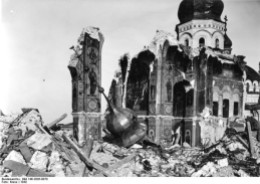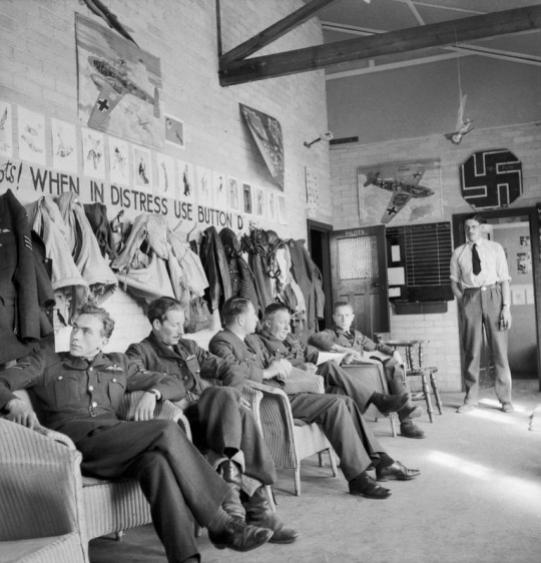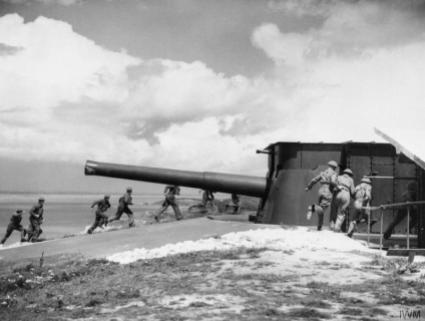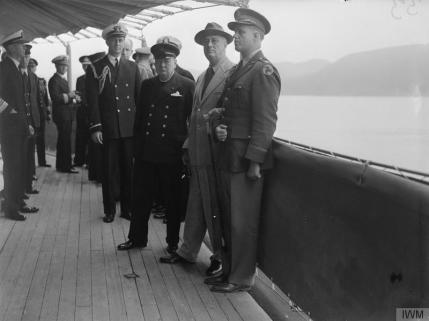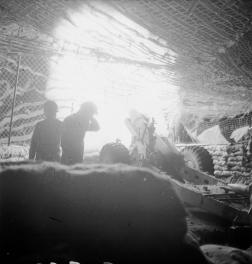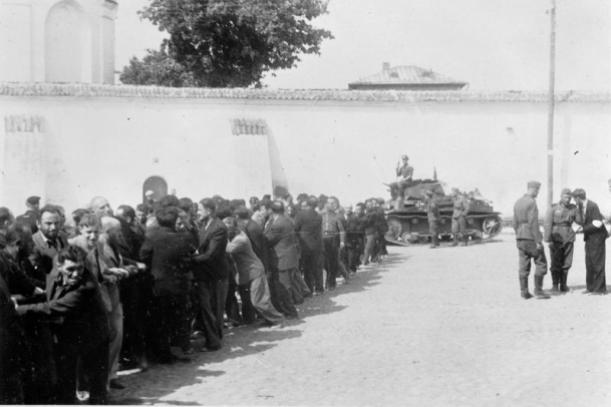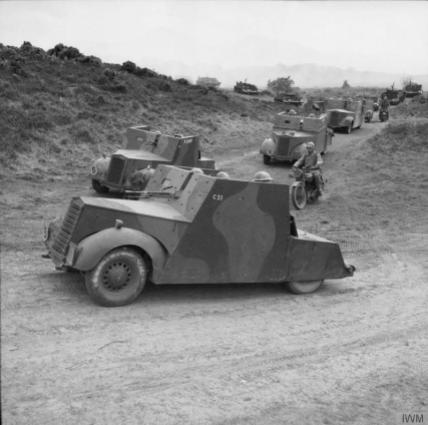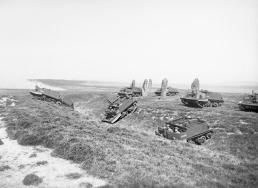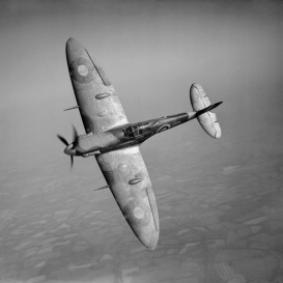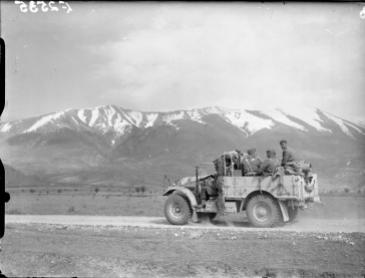ON THIS DAY IN WORLD WAR II, 75 YEARS AGO…
Photos from this month in WW2 ©IWM. Follow the twitter feed.

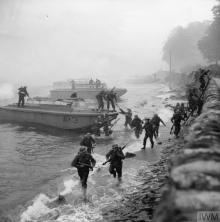





August, 1941: Photos from this month in WW2 ©IWM. Follow the twitter feed for details on each photo.

July 1941, from the Battle of the Atlantic
© IWM (C 1988) A Focke-Wulf Fw 200 Kondor sinking in the Atlantic Ocean west of Ireland, after being shot down by a Lockheed Hudson Mark V of No. 233 Squadron RAF based at Aldergrove, County Antrim, while trying to attack a convoy, 23 July 1941. This oblique aerial photograph was taken from the victorious Hudson (AM536) and shows the crew of the Kondor swimming for their liferaft which is inflating to the right of the tailplane.





July, 1941: Photos from this month in WW2 ©IWM. Follow the twitter feed for details on each photo.





June, 1941: Photos from this month in WW2 ©IWM. Follow the twitter feed for details on each photo.






24 May – 6 June, 1941: Photos from this week in WW2 ©IWM. Follow the twitter feed for details on each photo.





23 May, 1941: The Reconquest of Abyssinia (Ethiopia) ©IWM

Dejazmatch ‘Ras’ Gerressu Duki watches his army cross the Omo River into Italian territory

With banners born proudly aloft Ras’s locally raised patriot army swept through the rapid waters of the river into enemy territory

700 men of Ras’s huge army plunge into the rapids of the Omo River with horses, donkeys and machine guns
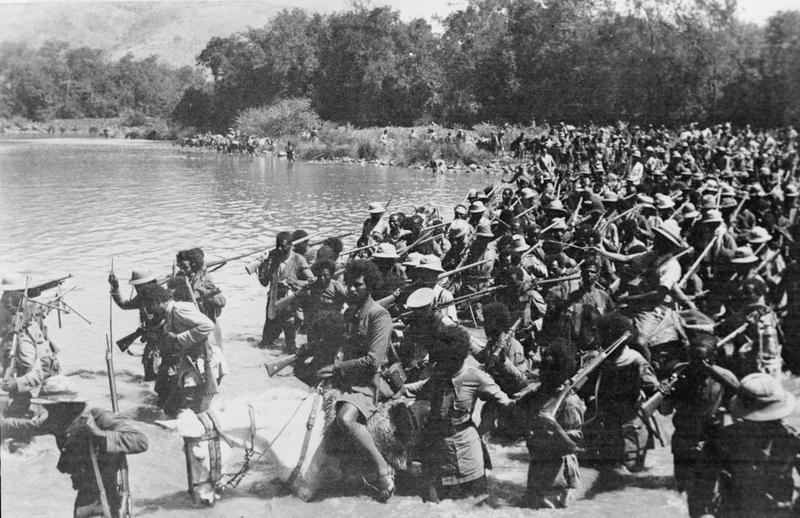
Ras rides on his white horse, in his green captured Italian uniform

Ras’s son Tefferra Gerressu, aged 15, who accompanied the Ethiopian Army, holding a sub-machine gun in camp





15-21 May, 1941: Photos from this week in WW2 ©IWM. Follow the twitter feed for details on each photo.
8-14 May, 1941: Photos from this week in WW2 ©IWM. Follow the twitter feed for details on each photo.





For details on A Chance Kill, click here
1-7 May, 1941: Photos from this week in WW2 ©IWM. Follow the twitter feed for details on each photo.


















24-30 April, 1941: Photos from this week in WW2 ©IWM. Follow the twitter feed for details on each photo.





18-24 April, 1941: Photos from this week in WW2. See twitter feed for details of each photo.





11 APRIL, 1941: RAF gain ‘Flying Fortress’ bombers from USA

The Lend-Lease deal signed by Roosevelt and Churchill in 1941 led to twenty B17’s being sent to Britain for Bomber Command.
The first one to fly to Britain crashed. On July 8th 1941, two B17’s went on an RAF op to attack the naval base at Wilhelmshaven (see the link for Britain’s first offensive of WWII, in 1939). However, the B17’s guns froze and bombing accuracy was poor. So the B17 was withdrawn from RAF service for a time.
The B17 for USAF: Later in 1941, when the Japanese attacked Pearl Harbor, B17’s were already there, based at Hickham Air Base. They were attacked on the ground and 12 bombers were lost. The attack on Pearl Harbor spurred America into maximising its military production, including Boeing’s production of B17’s. The B17 Flying Fortress would soon be used for bombing Nazi Germany.





6 APRIL, 1941: RAF Flying Officer Kenneth Campbell takes on prime German battleship

The new German battleships Scharnhorst and Gneisenau operated together, raiding British merchant shipping in the Atlantic. They had the capability to accurately fire a longer distance than had been accomplished in battle before. This they demonstrated during the German invasion of Norway, where the two battleships sank aircraft carrier HMS Glorious (8 June 1940).
On 6 April 1941 Flying Officer Campbell piloted his Bristol Beaufort bomber across the Channel to northern France. His target, the Gneisenau, was inside Brest’s inner harbour. Precision was key, so Campbell flew through a barrage of concentrated anti-aircraft fire from perhaps 1000 weapons of various calibre.
In order to circumvent the anti-torpedo barrier rimming the harbour, Campbell flew in close and released the torpedo from 50 feet. The torpedo hit the Gneisenau below the waterline, putting the ship out of action for six months.

Campbell’s getaway involved a steep banking turn, allowing the gunners below ample opportunity to hit the aircraft. The Beaufort was shot down, crashing into the harbour, and killing Campbell and his three crew mates, Sergeants J. P. Scott DFM RCAF (navigator), R. W. Hillman (wireless operator) and W. C. Mulliss (air gunner). Flying Officer Campbell was posthumously awarded the Victoria Cross.

Portrait of Kenneth Campbell RAF, awarded the Victoria Cross: France, 6 April 1941. © IWM (CH 4911)





31 MARCH, 1941: RAF drops huge, new bomb
Bomber Command dropped its first 4,000-pound bombs. The target was the port city of Emden, Germany, and the aircraft designated for the operation was a Vickers Wellington Mark II.
Left: Wellington aircrew of No 149 Squadron at Mildenhall on 1 May 1941. On the night of 31 March – 1 April 1941, during a raid on Emden, a specially modified Wellington flown by Pilot Officer J H Franks (centre, with moustache) dropped one of the first two 4,000lb high-capacity (HC) blast-bombs of the war. © IWM (CH 17196)
Right: Vertical aerial photograph taken from Vickers Wellington Mark II, W5439 ‘OJ-X’, of No. 149 Squadron RAF during a night raid on Emden, Germany, showing fires and smoke rising from explosions in the town, 31 March – 1 April 1941. Two Wellingtons were modified to carry 4,000-lb HC blast bombs (‘cookies’) which were dropped for the first time during this attack. © IWM (C 1888)





27-29 MARCH, 1941: The Battle of Cape Matapan
On March 27, Royal Navy battleships HMS Warspite, HMS Barham, HMS Valiant, aircraft carrier HMS Formidable and nine destroyers of the British Mediterranean Fleet meet an Italian fleet, off southern Greece.
Left: Lt Clifford’s torpedo being released, as seen by Mid Wallington, Observer in second aircraft.© IWM (A 9801)
Right: Vittorio Veneto firing during Battle of Matapan near Gavdos, Greece, 27 Mar 1941. From ww2db.com
On the morning of March 28, 150 miles off Cape Matapan three Italian cruisers, later joined by the big guns of Italian battleships attack four Allied cruisers, damaging all four by near misses. In the afternoon, Allied torpedo bombers from HMS Formidable attack, temporarily knocking battleship Vittorio Veneto (pictured below) out of action (for about 90 minutes) at the cost of one aircraft. In the evening, the carrier HMS Formidable engages the ships, hitting Italian cruiser Pola and but failing to catch Vittorio Veneto as she limped back to Taranto, Italy. After dark, British battleships HMS Barham, HMS Valiant, and HMS Warspite moved in on the Italian cruisers undetected, opening fire at 2330 hours.

Enter a caption
Above: Fairey Albacore Mark Is of Nos. 826 and 829 Squadrons ranged on board HMS FORMIDABLE before taking off to attack the Italian Fleet during the Battle of Matapan, 28 March 1941. (From SIMPKINS L C (MR) photographs, Imperial War Museum.)
In the early hours of March 29, Italian cruisers Fiume and Zara, plus destroyers Alfieri and Carducci, are sunk, while destroyer Oriani is damaged. British destroyers HMS Jervis and HMS Nubian capture the crew of damaged Italian cruiser Pola, and sink her with torpedoes.
In all, the British rescued 905 Italian sailors before they hurry away, fearing a Luftwaffe attack.
The Battle of Cape Matapan saw 5 Italian warships lost, with 2,303 men killed. The British suffered only 3 killed, the air crew of the torpedo bomber lost on 28 Mar 1941.
(Thanks go to ww2db.com)





27 MARCH, 1941 – Dessert manoeuvres
Left: A lorry mounted anti-tank gun in the Western Desert being manned by New Zealand LRDG troops as they return to Cairo, 27 March 1941. © IWM (E 2301)
Right: The Axis Offensive 1941 – 1942: A Long Range Desert Group truck negotiates the slope of a sand dune during a patrol in the desert. © IWM (E 2298)





25 MARCH, 1941
Pilot Officer Kennedy of No. 47 Squadron RAF Detachment inspects the damage to his Vickers Wellesley (K7715 ‘KU-H’)

Pilot Officer Kennedy was attacked by two Fiat CR 42s while on a bombing sortie over Keren, Eritrea on 25 March 1941. His air gunner, Sergeant German, was mortally wounded and the port wing was set on fire. Kennedy executed a vertical dive to put out the flames and returned to the Detachment’s base at Agordat, where he crashed on landing. © IWM (CM 658)





23 MARCH, 1941
American Lend-Lease weaponry arrives in UK

Women of the ATS (Auxiliary Territorial Service) at the Central Ordnance Depot at Weedon in Northamptonshire, unpack Winchester rifles sent from the United States under the terms of Lease-Lend, 23 March 1942. © IWM (H 18074)

Thompson ‘Tommy’ submachine guns are unpacked by a corporal at an ordnance depot in the Midlands following their arrival from the United States of America through the Lend-Lease scheme on 23 March 1942. © IWM (H 18068)





20 MARCH, 1941
The British King and Queen visit Plymouth/Plymouth Blitz
King George VI and Queen Elizabeth tour Plymouth, including the docks. They also enjoy afternoon tea with Lady Nancy Astor, the first woman to sit in the House of Commons. The Royal “gala day” brought out crowds of people, with bands and dancing on Plymouth Hoe.

Source: Imperial War Museum
As soon the Royal party departed, 125 German bombers whirred into view. They targeted the city centre and the docks, sinking two tug boats – HMS Sir Bevois (9 killed) and HMS Elan – plus transport ship Mari II.





18 MARCH, 1941
Swordfish torpedo bombers raid Tripoli
Fairey Swordfish aircraft of 830 Naval Air Squadron of the Royal Navy Fleet Air Arm squadron, formed in Malta in July 1940, bomb Tripoli, Libya. One Swordfish was shot down, but its crew survived: A/Sub-Lt D Grant and Leading Airman W E J Thomson were made prisoners of war.

During 1940–41, the Swordfish torpedo bombers based in Malta carried out attacks against the Axis supply route from Italy across the Mediterranean to North Africa, most famously in the Battle of Taranto in November 1940. The Japanese – neutral vis-a-vis Britain, at this time – studied the British attack on Taranto harbour: it helped the Japanese as they formed their plans to attack Pearl Harbor.





16 MARCH, 1941
Operazione Primavera
Incensed after four months of war without victory against Greece, Mussolini arrived in Tirana, Albania, early in March 1941 in order to direct Operazione Primavera (the Spring Offensive) himself: this was announced on Italian radio.

Mussolini near the front line in Albania. Source: Kotenikkote Files
On March 9, 1941, Italy unleashed Operazione Primavera, a huge counter-offensive in southern Albania which aimed to break through a stretch of the front line (at Boubesi). The offensive began with an artillery and aircraft bombardment of Greek positions. Then, under General Carlo Geloso, eleven infantry divisions, plus the 131st Armoured Division, attacked six divisions of the Greek army. At the heart of the action was the 1st Greek Division of Larissa, which had been fighting determinedly and continuously since the beginning of the war.
The Italian infantry repeated assaulted the front line in a mountainous area between two rivers, Osum and Vjosë. Fierce fighting occurred on ‘Height 731’ – a hilltop of 731 metres in altitude – which the Italians attacked and attempted to take at least 18 times. The Greek forces held their ground and, at times, counter-attacked. Crucial to the Greeks was that their artillery remained strong, as did the morale of Greek troops.
On 14 March, Italian General Ugo Cavallero relayed to Mussolini that the attacks had failed. On March 16, Il Duce called an end to the Primavera offensive.





14 MARCH, 1941
Glasgow bombed for second consecutive night
The night following the first bombing of Glasgow (see below), 200 bombers returned to Glasgow and Clydebank, damaging shipyards and the Rolls Royce aircraft engine factory. Over the two nights, 528 civilians were killed and 48,000 civilians lost their homes; the Clydebank tenements, where shipyard workers and their families lived, were badly hit.
The British Admiralty (naval ministry) responded by placing an order for a new battleship to be built at Clydebank.





13 MARCH, 1941
Glasgow bombed
Over the night of March 13-14, 260 German bombers attack Glasgow and Clydeside, Scotland, for the first time. They drop high-explosive bombs, incendiary bombs and parachute-mines over a nine-hour period. They target munitions factories and docks, sink 3 cargo ships and damage 2 destroyers.

A German reconnaissance photograph annotated with target markings used by the Luftwaffe. Source: ww2today





12 MARCH, 1941
Churchill thanks the USA
British Prime Minister Winston Churchill thanks the United States for ‘a new magna carta’ – referring to the Lend-Lease Act President Roosevelt signed into law the previous day. It enables the US to lend the UK, China + other allies armaments for which they do not have to pay until after the war.

Source: Library of Congress





Portsmouth, UK, is heavily bombed
Overnight (March 10-11), a thousand people are made homeless, 93 are killed and over 250 injured. In the naval dockyard, minesweeping trawler HMT Revello are sunk and destroyers HMS Sherwood, HMS Witherington, HMS Tynedale are damaged, as is training ship HMS Marshal Soult and four minesweeping trawlers.

Yellow target areas, plus where the bombs actually fell. Source: portsmouthblitz.co.uk





10 MARCH, 1941
The Handley Page Halifax makes its operational debut

The Handley Page Halifax. Source: raf.mod.uk
During the evening of March 10, six RAF Halifax bombers of No. 35 Squadron of No. 4 Group set off from Linton-on-Ouse, Yorkshire, UK to attack Le Havre, France. Upon their return, one of the four-engine heavy bombers is inadvertently shot down by an RAF nightfighter.
The Halifax would go on to serve in North Africa and drop paratroopers during the liberation of Europe. It also performed ‘special duties’ with the Special Operation Executive (SOE), parachuting secret agents and arms into occupied Europe.
Also on March 10: Uboat U552 sinks Iceland’s Reykjaborg trawler. 12 die. Of 3 survivors, 1 will die before UK’s HMS Pimpernel arrives four days later.
My Twitter feed has been following every day of World War II, beginning in September 1939:







